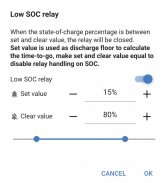So since voltage isn't the best way to indicate SOC with LiFePO4 does anyone know of a BMS which allows protection at x% energy levels (i.e. watt hours)?
I've been considering doing a PIC controlled implementation myself but I'd much rather get something off the shelf if it's not too expensive.
I don't understand, for example, why my ANT BMS which apparently knows the energy level of the battery only allows me to define cut off levels, low and high, based on voltage (which is not precise enough to hit the cutoffs I want, ie 15% on the bottom and 15% on the top).
Does anyone know of an affordable solution to base BMS operations on energy level instead of simply on voltage?
This seems like a holdover from Lead Acid tech...
I've been considering doing a PIC controlled implementation myself but I'd much rather get something off the shelf if it's not too expensive.
I don't understand, for example, why my ANT BMS which apparently knows the energy level of the battery only allows me to define cut off levels, low and high, based on voltage (which is not precise enough to hit the cutoffs I want, ie 15% on the bottom and 15% on the top).
Does anyone know of an affordable solution to base BMS operations on energy level instead of simply on voltage?
This seems like a holdover from Lead Acid tech...




